- Home
- L. Ron Hubbard
Writers of the Future Volume 34 Page 2
Writers of the Future Volume 34 Read online
Page 2
Ultimately, as I put the anthology together, I am hoping that I can find diverse types of stories. I want to have strong fantasy pieces, whether they be medieval, contemporary, magical realism, or so on. I also want strong science fiction, whether set on Earth, in space, or on other worlds. I want some creepy horror in the anthology, and I am always searching for top-notch humor.
This year, I’m happy to say that our authors and artists really delivered some exceptional work! So go ahead and dive in. Their artistry will take you to distant worlds in the far future or will explore original fantasy landscapes. You’ll find authors who know how to tell a powerful story and write exquisitely. And hopefully we will help you discover one of your new favorite artists of all time!
Illustrators of the Future
by Echo Chernik
* * *
Echo Chernik is a successful advertising and publishing illustrator with twenty years of professional experience and several prestigious publishing awards.
Her clients include mainstream companies such as: Miller, Camel, Coors, Celestial Seasonings, Publix Super Markets, Inc., Kmart, Sears, NASCAR, the Sheikh of Dubai, the city of New Orleans, Bellagio resort, the state of Indiana, USPS, Dave Matthews Band, Arlo Guthrie, McDonald’s, Procter & Gamble, Trek Bicycle Corporation, Disney, BBC, Mattel, Hasbro and more. She specializes in several styles including decorative, vector, and art nouveau.
She is the Coordinating Judge of the Illustrators of the Future Contest. Echo strives to share the important but all-too-often neglected subject of the business aspect of illustration with the winners, as well as preparing them for the reality of a successful career in illustration.
Illustrators of the Future
There are some people born with the soul of an artist. To these lucky few, the act of creation is like breathing—it is not optional. Artists feel the undeniable need to create and possess an inherent inclination and talent for it, but the recipe for making a living as a successful artist takes more than just talent. It also takes a great amount of desire and ambition, a hefty dash of business sense, and a stubborn streak of will and perseverance to persist in becoming a success regardless of obstacles.
If you dream of a career as a commercial artist, then the Illustrators of the Future Contest is for you. The Contest was created by L. Ron Hubbard to give people with these qualities a step up, a shortcut up the cliff of adversity. It’s an amazing opportunity for artists who wish to make a living as illustrators. I only wish that I’d known about the Contest in the early years of my career.
The Contest was founded by Hubbard on the concept that “a culture is as rich and as capable of surviving as it has imaginative artists.” I am honored to be the Coordinating Judge for the Illustrators of the Future Contest and to have the very special opportunity—again in the words of Hubbard—to “give tomorrow a new form” by helping young illustrators achieve a strong start. I am extremely pleased to be surrounded by prestigious judges and past winners who dedicate their time and effort because they feel the same.
Participating is easy and free. This Contest was set up to help artists, and it’s legitimately one of the best opportunities a young artist can have.
All you have to do is submit three pieces of your best work through www.illustratorsofthefuture.com. You can enter four times a year (quarterly). Finalists are chosen by a panel of industry expert judges. We see entries from all over the world, and you don’t even need to speak English to enter or win. Each quarter, three Contest winners are chosen, so at the end of the year, there are a total of twelve winners for the year! Each winner receives a cash award, the opportunity to be published in the renowned annual L. Ron Hubbard Presents Writers and Illustrators of the Future anthology, as well as the chance to win the grand prize.
The winners are flown to Hollywood for a huge black-tie celebration and book signing, as well as an entire week learning the ins and outs of being a successful commercial artist in today’s world. There are seminars and lectures by famous illustrator judges and guest speakers. It’s an invaluable experience centered on providing a head start to the Contest winners with the goal of leaving the young professional artists full of the knowledge and confidence to succeed. Galaxy Press has demonstrated their commitment to past winners by continuing to promote them and point out their accomplishments even after the Contest is over.
Imagine yourself as one of the illustrators. Here’s what would happen:
Once you are chosen as a winner, you are assigned a short story written by one of the Writers of the Future winners. You will then work with me (as art director) in the same manner as a working illustrator would work with a publishing house or client. You will submit three thumbnails, which we discuss, and then we will choose one to proceed with. I will help guide you through the process of creating a beautiful illustration for the story. I find that my own best pieces are ones that are not too overly art directed. I use a method of simple suggestion through the process, rather than overly directing—encouraging you to create a portfolio-quality piece that showcases your style, talent, and enthusiasm. I bring to your attention options for symbolism, composition, color scheme, and more that will help make the piece stronger—and then leave it up to you as the artist to interpret how you wish. This will be your published piece in the Writers of the Future anthology, and a strong portfolio piece to win work with.
Artists often struggle with the questions “But am I good enough to win?” “What if I’m not chosen?” “How do I have a better chance of getting chosen?” My best advice is to keep creating and keep entering. We don’t judge on style as much as we do on the ability to tell a story. I encourage applicants to try to send in pieces that illustrate a scene as opposed to still lifes.
“Be true to your work and your work will be true to you” is the motto of my alma mater, Pratt Institute. And truer words have never been spoken.
Artists are driven by passion and the desire to express themselves. This is true for not only fine artists, but commercial artists as well. You probably find that you have a favorite style or subject that you really pour yourself into. Other people can see the passion that you put into those particular pieces. Do what you love, and you will find or create a niche for it. Trying to create work in a style that doesn’t excite you just to match a trend will never make you as successful as being true to yourself. And if the world doesn’t accept your style, keep at it. Keep creating new work, keep submitting to the Contest, and keep showing the world.
What I’m getting at is, if you submit to the Illustrators of the Future Contest and are not chosen, don’t give up! You can submit quarterly, and each quarter there is a different batch of entries. Keep believing in yourself and your art, and eventually other people will believe in you too!
Turnabout
written by
Erik Bundy
illustrated by
Adar Darnov
* * *
ABOUT THE AUTHOR
Erik lives in a magical North Carolina forest where mice claiming to be cousins move in for the winter then take the towels when they leave in spring. He suffers from the genetic disorder of being human. Unlike many writers, Erik doesn’t keep a cat, partly in deference to his mouse cousins and partly because he couldn’t live up to its expectations.
His hobbies are hunting dust bunnies with a fork, watching galaxies collide, bounty hunting for runaway socks, and sniffing for truffles while wearing a studded pit-bull collar.
Erik is a graduate of the six-week Odyssey Fantasy Writing Workshop. His story, “Turnabout,” was inspired by a visit to Morocco with a Spanish tour group.
ABOUT THE ILLUSTRATOR
Adar Darnov was born in New Jersey and mostly grew up there. He was creative as a kid, particularly through drawing. The synagogue where he spent much of his childhood was the breeding ground of his imagination. There he was familiarized with fanciful stories and played imaginative g
ames with friends. As an adolescent, his creativity continued to be supported by family.
Throughout middle and high school, he experimented with various artistic identities. He created comic book art, graphic designs and fine art paintings. These corresponded to the different artist mentors he encountered, each imparting on him a unique piece of the artist experience.
Adar eventually enrolled for his undergraduate degree in illustration at the School of Visual Arts in New York City. There he learned more about the career of illustration. Then Adar lost sight of the pure joy he derived from art as a child. Fortunately however, one semester he visited long-time friends who were playing popular fantasy board games. This reminded Adar how much he loved imaginative art when he was younger, especially art associated with the games, shows, and books he partook of. This combined with his growing attraction to objective art led him to pursue imaginative realism illustration.
After graduating SVA, he experienced many aspects of being an illustrator outside school. Adar continues his education at Academy of Art University in San Francisco, pursuing his master’s degree. This is the first time Adar’s imaginative realism art has been published.
Turnabout
After Stephanie left me, I vagabonded alone through the arid Rif Mountains of Morocco—humped under a backpack with dirhams and dollars in one dusty hiking boot and a credit card chafing a callus in the other. Her leaving wasn’t going to ruin my rambling.
Near an adobe village famous for being alabaster white in summer and lapis lazuli blue in winter, a sparkle of reflected sunlight snagged my curiosity. It came from under a skeletal bush with a few leathery leaves rattling in the wind. I sidled closer and saw a brass urn the size of my knobby fist. Maybe it had pearls or blood diamonds in it … something to lure Steph back to me.
The sun-hot brass stung my fingers, and I dropped it. The urn clinked on the rocky ground, and its little domed lid spilled off.
A snake’s head, tongue flickering, eased out of the urn’s mouth. I stood there like a doofus, too paralyzed to run, as a sinister blue-black cobra longer than my arm slithered impossibly out of the tiny vessel. The tip of the cobra’s tail was a shocking lipstick red.
Strung out beside the urn, it raised its head, hood flared, tongue flittering at me, and kept levitating upward until the cobra balanced on its red-tail point. Then it shimmered into a young Arab woman. Amazed, I was too fascinated to be scared.
She wore red embroidered slippers, leather pants, a vampire’s cape, and a dark scarf over her dark hair. Her slitted eyes gleamed like black ice, glassy and deadly.
I whipped a Hand of Fatima charm out of my pocket and shoved it at her face.
Her human tongue darted out between her thin lips. “Do not insult me, Westerner. What is your wish?”
“You’re a genie?” I’d thought genies were ponderous eunuchs who wore brocade vests and turbans … jinns who vapored out of brass lamps, not urns. “Don’t I get three wishes?”
“One wish frees me from my obligation to you, man of clay.”
Yeah, and be careful what you wish for. All jinns had a slithery side. What if I asked for fame and got arrested as a serial killer? Or if I asked for riches and my loved ones, or loved one if Steph came back to me, were kidnapped for ransom. If I wanted a long life, would I spend most of it comatose in a hospital bed?
“Is there a downside to my making this wish?”
She stared across the desolate khaki-colored hills and scrub brush with a martyr’s expression. Her tongue tasted the dry air. “I must give you a wish, Westerner, but its consequences come to you. I am not your protector. No one is free from fate.”
Was it just coincidence that two days after Steph stomped out of my life, a jinni popped into it? As for my wish, well, Steph had abandoned me in noisy Tangier, so I said, “Okay, I wish for you to make a woman I know love me enough to stay with me. For the rest of my life.”
The jinni’s face drooped into a please-deliver-me expression. “I cannot change your human nature.”
“So you’re saying you’re limited in what you can do for me? First off, I don’t get the usual three wishes, then you refuse even to honor my one wish?”
“I can give you gold ingots, a marble palace, things you may touch. I cannot make this woman fall in love with you, man of clay. I cannot make you more agreeable to her.”
Inwardly, I flinched. Steph’s last words to me, not exactly whispered, more like shouted in the souk, called me a suffocating, selfish prick. I considered myself loyal and helpful, the opposite of selfish. And yeah, sometimes when people pushed me I did come across as a bit contrary.
Now this jinni was pushing me. A free wish without any obligation on my part seemed way too good to be harmless. Everything comes with a price tag tied to it.
“It’s odd that I’m the one who found your urn.” I waved at the leached-out country around us. “I mean, I’m not following a caravan route or a shepherd’s path or anything.”
She looked ready to turn me into a donkey turd.
I quickly asked, “What would you wish for?”
Her eyes flickered toward the brass urn then away. “What does it matter, Westerner? You cannot grant it.”
Her glance had given me my answer: she wanted freedom. Who wouldn’t? “My name’s Layton, by the way.”
Her lip curled. I was just a talking cockroach to her.
Well, this cockroach didn’t take orders from genies, especially limited ones. “Okay, how about if I call you Jenny? Listen, Jenny, since this is a one-time deal, I need to think. I want to get this wish absolutely right.”
Her womanly form crumpled into a muscular blue-black cobra with a red tail. I stood there, my jaw almost hanging down to my belt buckle, and watched the snake slither away without even a backward hiss.
The jinni had left her brass urn behind, so I stuffed it into my backpack. A genie’s prison probably wasn’t disposable. I had the promise of a wish and meant to keep that option alive.
Tomorrow was probably going to be an interesting day.
In Morocco, breakfast meant hot sweet tea and two or three crusty pastries filled with almond pudding. Afterward jittering with a sugar rush, I wandered the claustrophobic passages of the clamorous medina, the old quarter. As usual, boys pestered me to buy key chains with Moroccan flags on them, cheap Citizen watches, or bootleg beaded necklaces. Most of them gave up whining and begging alongside of me after ten yards, but one lanky kid leeched onto me. I kept shooing him away, but he harassed me like a blood-starved mosquito. He had the usual short dark hair and peanut-butter skin and wore a faded black T-shirt and jeans. For some reason, his glaring red trainers disturbed me.
He stubbornly pulled junk souvenirs out of a goat-leather bag. He also offered me kif, hashish. As a young guy humping a backpack, I was used to this. Then he held up a silver teardrop pendant dangling on a delicate chain. It was set with blue lapis lazuli.
I shrugged it away, but his huckster eyes saw through my fake disinterest. He was holding the perfect peace offering for Steph. She adored lapis lazuli.
The boy chuckled. “You wish this?”
My brain clicked into revelation. I glanced down at his red trainers, then into his black-hole eyes. The jinni shouldn’t have used the word “wish.” I consciously relaxed to hide my anger. I had been one word away from losing my wish. “So what happens if I die, Jenny? Would that wipe away your obligation to me?”
A spasm of hatred squirmed across the boy’s face. “Yes.”
“But you can’t be the one who does me in, can you?”
A grimace of regret was her answer.
“Nice to know,” I told her. “Tell me, why is my making this wish so important to you?”
A laborer yelled for us to move aside in the narrow passageway and led a donkey loaded with scrap wood between us.
When we came together again
, Jenny said, “It is the ritual I must follow.”
“Yeah, well, I don’t like being tricked. And I shun rituals I don’t understand. Tell you what, though. I’ll buy that necklace from you.” I pulled out a wad of dirhams. “How much do you want for it?”
Jenny threw the pendant and silver chain at me and stalked away with reptilian grace. To a shape-shifting fire demon, money was just paper with the grainy portrait of a king on it.
But maybe I could give this jinni something it did value. Of course, I too was limited in what I could offer. Still, partial freedom, something resembling house arrest, had to be preferable to a cramped brass prison.
I knew better than to expect gratitude. The jinni was a yin and yang creature, sometimes a snake which represented earth, and sometimes earth’s elemental opposite, fire. My reward would be in having a travel companion.
I decided to ramble down to the sea and send Steph the peace-offering pendant from feisty Tangier, the seaport where we had parted. So I started to zigzag my way through the crowded medina to the bus station.
A very traditional woman fell into step three paces behind me. She plodded along in an ankle-length, black abaya smelling of myrrh. Her incongruous red slippers let me know trouble stalked my footsteps. My brown skin, brown eyes, and dark hair tended to blend me in with the locals. So having a pretty, young wife in tow didn’t raise any eyebrows.
She followed me into the well-worn bus station as if I had her on a leash. At the ticket counter, I asked a young clerk who smelled of rose perfume and wore a flowery silk scarf if I could speak English. She wiggled her shoulders shyly and told me she spoke a little English. She sounded as if she had been born in London and read The Economist.
“Did you study English in school?” I asked.
“I was educated in England,” she said with bashful pride.

 Fifty-Fifty O'Brien
Fifty-Fifty O'Brien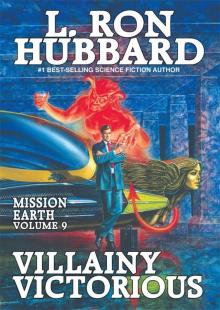 Villainy Victorious
Villainy Victorious Spy Killer
Spy Killer Ai! Pedrito!: When Intelligence Goes Wrong
Ai! Pedrito!: When Intelligence Goes Wrong The Dangerous Dimension
The Dangerous Dimension Mission Earth Volume 1: The Invaders Plan
Mission Earth Volume 1: The Invaders Plan The Slickers
The Slickers If I Were You
If I Were You The Doomed Planet
The Doomed Planet Writers of the Future Volume 31
Writers of the Future Volume 31 Mission Earth Volume 2: Black Genesis
Mission Earth Volume 2: Black Genesis Writers of the Future: 29
Writers of the Future: 29 Death Quest
Death Quest The Enemy Within
The Enemy Within Orders Is Orders
Orders Is Orders Hell's Legionnaire
Hell's Legionnaire L. Ron Hubbard Presents Writers of the Future 34
L. Ron Hubbard Presents Writers of the Future 34 The Scifi & Fantasy Collection
The Scifi & Fantasy Collection Dead Men Kill
Dead Men Kill Ole Doc Methuselah: The Intergalactic Adventures of the Soldier of Light
Ole Doc Methuselah: The Intergalactic Adventures of the Soldier of Light Shadows From Boot Hill
Shadows From Boot Hill Hurricane
Hurricane Mission Earth Volume 3: The Enemy Within
Mission Earth Volume 3: The Enemy Within Slaves of Sleep & the Masters of Sleep
Slaves of Sleep & the Masters of Sleep One Was Stubborn
One Was Stubborn Final Blackout: A Futuristic War Novel
Final Blackout: A Futuristic War Novel Devil's Manhunt
Devil's Manhunt A Matter of Matter
A Matter of Matter Voyage of Vengeance
Voyage of Vengeance If I Were You (Science Fiction & Fantasy Short Stories Collection)
If I Were You (Science Fiction & Fantasy Short Stories Collection) L. Ron Hubbard Presents Writers of the Future Volume 35
L. Ron Hubbard Presents Writers of the Future Volume 35 Mission Earth Volume 4: An Alien Affair
Mission Earth Volume 4: An Alien Affair Black Genesis
Black Genesis Tinhorn's Daughter
Tinhorn's Daughter Trouble on His Wings
Trouble on His Wings Writers of the Future Volume 27: The Best New Science Fiction and Fantasy of the Year
Writers of the Future Volume 27: The Best New Science Fiction and Fantasy of the Year Writers of the Future Volume 28: The Best New Science Fiction and Fantasy of the Year
Writers of the Future Volume 28: The Best New Science Fiction and Fantasy of the Year An Alien Affair
An Alien Affair Cargo of Coffins
Cargo of Coffins Mission Earth Volume 5: Fortune of Fear
Mission Earth Volume 5: Fortune of Fear Writers of the Future 32 Science Fiction & Fantasy Anthology
Writers of the Future 32 Science Fiction & Fantasy Anthology The Baron of Coyote River
The Baron of Coyote River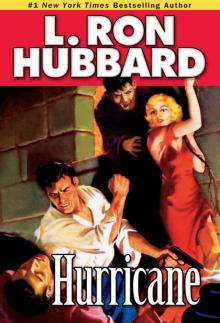 Hurricane (Stories From the Golden Age)
Hurricane (Stories From the Golden Age) Dianetics: The Modern Science of Mental Health
Dianetics: The Modern Science of Mental Health Writers of the Future, Volume 30
Writers of the Future, Volume 30 Battlefield Earth: A Saga of the Year 3000
Battlefield Earth: A Saga of the Year 3000 Fear
Fear Disaster
Disaster Invaders Plan, The: Mission Earth Volume 1
Invaders Plan, The: Mission Earth Volume 1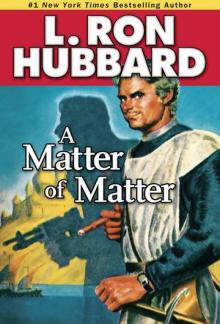 A Matter of Matter (Stories from the Golden Age)
A Matter of Matter (Stories from the Golden Age)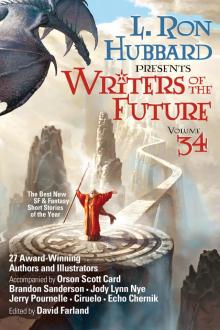 Writers of the Future Volume 34
Writers of the Future Volume 34 Death Waits at Sundown
Death Waits at Sundown One Was Stubbron
One Was Stubbron If I Were You (Stories from the Golden Age)
If I Were You (Stories from the Golden Age) Writers of the Future 32 Science Fiction & Fantasy Anthology (L. Ron Hubbard Presents Writers of the Future)
Writers of the Future 32 Science Fiction & Fantasy Anthology (L. Ron Hubbard Presents Writers of the Future) Writers of the Future, Volume 29
Writers of the Future, Volume 29 Mission Earth Volume 8: Disaster
Mission Earth Volume 8: Disaster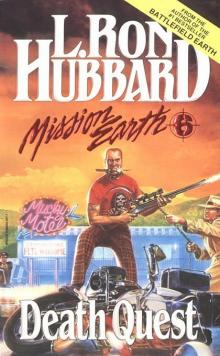 Mission Earth 6: Death Quest
Mission Earth 6: Death Quest Writers of the Future, Volume 27
Writers of the Future, Volume 27 Mission Earth Volume 7: Voyage of Vengeance
Mission Earth Volume 7: Voyage of Vengeance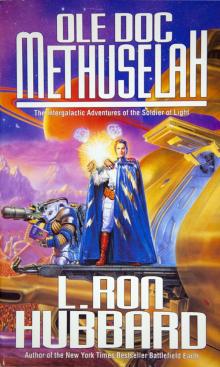 Ole Doc Methuselah
Ole Doc Methuselah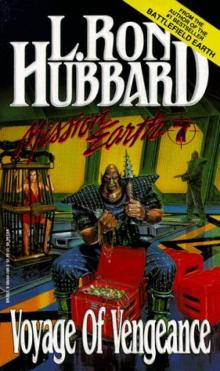 Mission Earth 07: Voyage of Vengeance
Mission Earth 07: Voyage of Vengeance Battlefield Earth
Battlefield Earth Fortune of Fear
Fortune of Fear Mission Earth 8: Disaster
Mission Earth 8: Disaster Mission Earth Volume 10: The Doomed Planet
Mission Earth Volume 10: The Doomed Planet Writers of the Future, Volume 28
Writers of the Future, Volume 28 Mission Earth Volume 6: Death Quest
Mission Earth Volume 6: Death Quest Dead Men Kill (Stories from the Golden Age)
Dead Men Kill (Stories from the Golden Age) Mission Earth 4: An Alien Affair
Mission Earth 4: An Alien Affair Spy Killer (Stories from the Golden Age)
Spy Killer (Stories from the Golden Age) Mission Earth Volume 9: Villainy Victorious
Mission Earth Volume 9: Villainy Victorious L. Ron Hubbard Presents Writers of the Future, Volume 33
L. Ron Hubbard Presents Writers of the Future, Volume 33